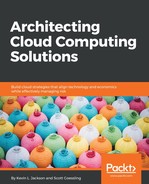IaaS is often deployed on-demand in small increments (cores, RAM, storage, network) with billing occurring in small increments of time. Instead of spending the capital (CAPEX) for a large four or eight-core server (which is the smallest currently available from some manufacturers), a right-sized virtual server can be acquired and deployed as a service, matching infrastructure size to cost and immediate need. This flexibility allows for infrastructure to be quickly matched to business strategies and economic constraints.
IaaS can include many of the infrastructure components included in traditional deployments. Firewalls can be virtual or physical. Compute and storage can be deployed across many different styles and platforms. Each service provider has their unique mix of technology and services. Ultimately the goal when using IaaS is to forget about infrastructure management and details and acquire the mix of services needed, when needed, solving the requirements at that time.
IaaS was one of the first cloud models available and has seen significant adoption in nearly all sectors. With IaaS, the user does not manage or control the infrastructure directly, only the software and functions loaded onto it (that is operating system, application). There are different types to choose from with varying levels of management and monitoring available for the underlying hardware, virtualization layers, firewalls, SANs, switches, routers, network interface cards (NIC), and related service level agreements (SLAs). The controlled risk and lower economic entry points for IaaS are attractive to new cloud adopters as well as savvy veterans. Controllable cost and controllable risk provide extra incentive to those trying to modernize through the adoption of the cloud.
The delivery of on-demand capacity is typically handled via self-service online customer portals. The portal provides complete visibility and control of the IaaS environment. Self-service portals enable and automate functions for adds, moves, changes, managing, and reporting without engaging and waiting for other resources internally or within the provider. IaaS can have many different consumption models matching various OPEX and CAPEX requirements. When using IaaS, there is no need to invest capital up front based on compute and storage resources forecasts. IaaS enables infrastructure to be purchased in increments, as needed, to match utilization.
For organizations, IaaS usage metering provides a higher level of detail used to trend utilization and chargeback specific departments or functions based on actual utilization. Detailed measurements and reporting also allow for instant, and in some cases, automatic, scaling up, and down based on dynamic need requirements. Resource flexibility is particularly useful when there are significant spikes, dips, or cyclical loads for infrastructure.
A few examples of current IaaS providers are Amazon Web Services, Microsoft Azure, and Google. They offer many different styles of compute, storage, and network, as well as many supporting solution services. They each offer several different economic models to match up to SLAs, OPEX and CAPEX requirements, risk and deployment options.
